ON GOING PROJECTS
 PTC-SN (CEA): TBKOSTER (Tight-Binding Kernel of Objects for Spinorbitronics Enhanced Research): The aim of TBKOSTER is the development of a generic tight-binding modelling platform for spin-orbitronics.
PTC-SN (CEA): TBKOSTER (Tight-Binding Kernel of Objects for Spinorbitronics Enhanced Research): The aim of TBKOSTER is the development of a generic tight-binding modelling platform for spin-orbitronics.
Project leader: CEA, SPEC (C. Barreteau)
Partners: CEA, DAM Le Ripault (P. Thibaudeau)
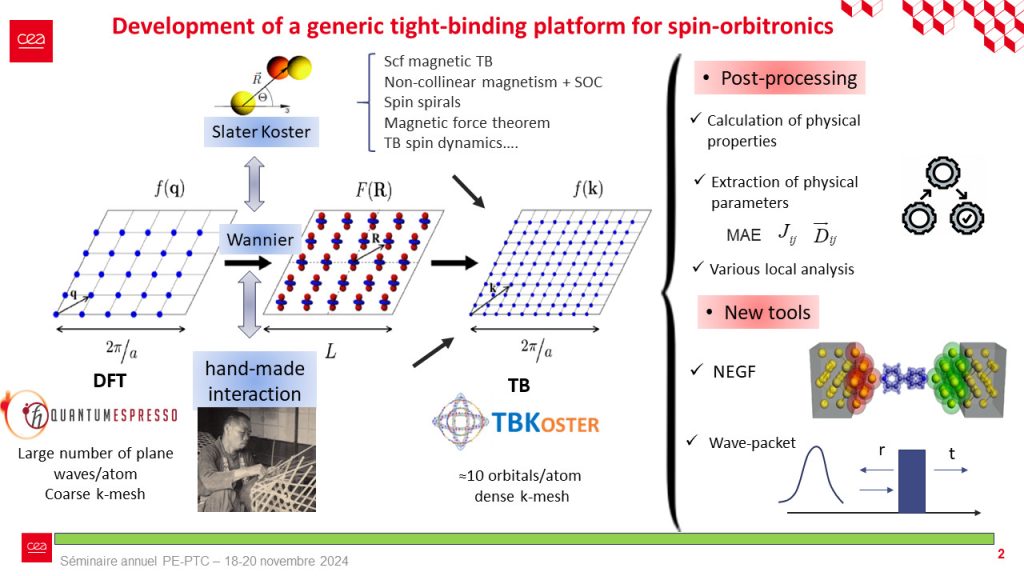
![]() PathFinder Project: OBELIX (Orbital engineering for Innovative Electronics): OBELIX will set the stage for an entirely new technology based on the physics of the electron orbital moment enabling the design of novel low-power functional ICT components, largely free from scarce materials such as Pt-group and rare-earth metals.
PathFinder Project: OBELIX (Orbital engineering for Innovative Electronics): OBELIX will set the stage for an entirely new technology based on the physics of the electron orbital moment enabling the design of novel low-power functional ICT components, largely free from scarce materials such as Pt-group and rare-earth metals.
Project leader: CNRS, CINAM (A. Manchon)
Partners: CEA, Saclay / Johannes Gutenberg University (M. Klaui) / Martin Luther University (I. Mertig), Uppsala University (Oppeneer) / Thales Group (H. Jaffres)
Labex NanoSaclay Project: BOGART (Bottom-up Synthesis and Properties of Graphene Related Materials) The project BOGART aims to develop new routes of synthesis of graphene related materials: Graphene quantum dots (GQDs), Graphene nanoribbons (GNRs) and Graphene Nanomeshes (GNMs), and to exploit their optical and electronic properties.
Project leader: CEA, Nimbe (S. Campidelli)
Partners: CEA, SPEC (S. Latil) / CEA, Nimbe (S. Campidelli) / ENS PSaclay, Lumin (J.S. Lauret)/CNRS-UPSaclay ICCMO (Vincent Huc)
ANR Project: GANESH (Graphene Nanomesh) The aim of the project GANESH is to design and fabricate via the bottom-up approach 2-dimensional graphene sheets containing a well-defined network of holes (graphene nanomeshes) and to evaluate their optical and electronic properties through a combination of advanced experimental and theoretical studies.
Project leader: IM2NP, Marseille (S. Clair)
Partners: CEA, SPEC (S. Latil) / CEA, Nimbe (S. Campidelli) / ENS PSaclay, Lumin (J.S. Lauret)

ANR Project:ORION (Orbitronics in non-centrosymmetric structures)The aim of the project ORION is to harness the orbital degree of freedom to boost spin-orbit mediated spin-charge conversion effects. This project in based on a synergy between experiments and theory
Project leader: CINAM, Marseille (A. Manchon)
Partners: CEA, SPEC (C. Barreteau M. Viret) / CNRS THALES (H. Jaffres)
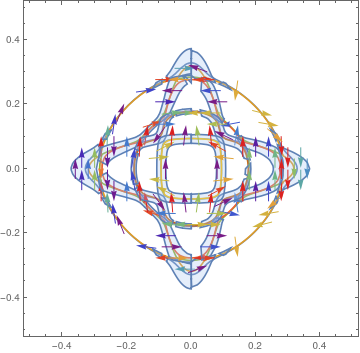
ANR Project: OERKOP (Oxygen evolution reaction: the key to optimize photocatalytic water oxidation)OERKOP aims to understand and describe the mechanisms underlying the Oxygen Evolution Reaction (OER), beyond the current state of the art, by using operando characterization approach applied to eco-friendly photoactive materials used as photoanodes. To reach our goal, we propose to implement a new correlative approach combining multi-scale and multi-selective techniques and complementary DFT calculations
Project leader: CEA, SPEC (D. Stanescu)
Partners: Synchrotron SOLEIL (S. Stanescu) / U. de Strasbourg, IPCMS (O. Ersen)
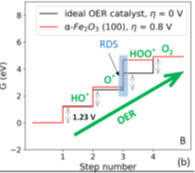
ANR Project: 2DPhostrainE (Surface stress engineering for growth and electronic properties of 2D phosphorus allotropes)The goal of this project is to discover new phases, with new properties, of two-dimensional (2D) phosphorus, or phosphorene, beyond the simple 2D few-layers black phosphorus (BP) in order to mastering the formation of phosphorene allotropes that can be useful for nanoelectronics, nanophotonics or catalysis applications
Project leader: U. de Paris, MPQ (Y. Girard)
Partners: CEA, SPEC (Y. Dappe) / U. Paris Saclay, LPS (A. Tejeda)

ANR Project: COMODES (Coherent Monolayer Field Emission Sources)We propose in this project to realize a field emission tip source terminated by functional “monolayers” to reach the coherent regime of electron emission. The monolayers will be designed to reduce the ”electron cavity” losses thus improving source monochromaticity.
Project leader: ILM, Lyon (A. Ayari)
Partners: IEMN, U. de Lilles (S. Lenfant) / C2N, U. Paris Saclay (J. Chaste) / CEA, SPEC (Y. Dappe)

ANR Project: SCOOPE (Semiconducting Conjugated Oligomers for Photo-driven O2 and H2 Evolution)SCOOPE focuses on the development of organic semiconducting materials for water photosplitting. We aim to provide an in-depth chemical and physical description of the nano-structured materials synthesized for this goal. Theoretical calculations will be performed to understand the four-electron, four-proton oxidation of water.
Project leader: ICP, U. Paris Saclay (H. Remita)
Partners: CEA, LPB (W. Leibl) / CEA, SPEC (Y. Dappe)
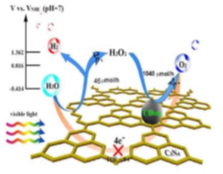
ANR Project: DEFINE2D (Defect engineering in 2D materials: atomic scale properties and molecular probing) – France / TaiwanThe goal of this project is to tune the properties of two dimensional (2D) materials, using a defect engineering technique that we will develop, in order to reach specific functionalities that can be useful for e.g. nanoelectronics, sensing or catalysis applications.
Project leader: U. de Paris, MPQ (J. Lagoute)
Partners: CEA, SPEC (Y. Dappe) / National Taiwan U. (W. W. Pai) / Academia Sinica, Taiwan (W. B. Su)
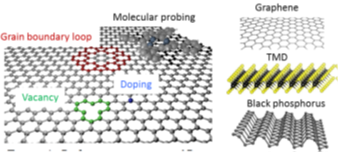
ANR Project: MIXES (Mixed dimensional van der Waals heterostructures for electronics and spintronics) We aim at developing a basic understanding of the growth mechanism(s), the structural, chemical and electronic properties of novel 2D-0D Mixed-dimensional van der Waals heterostructure, made of two dimensional material (“2D”) in interaction with zero dimensional (“0D”) nanoclusters.
Project leader: : U. de Strasbourg, IPCMS (J.-F. Dayen)
Partners: U. de Haute-Alsace, IS2M (L. Simon) / U. Paris Saclay, Umphy Thales (P. Seneor) / CEA, SPEC (Y. Dappe)
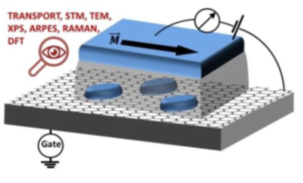
ANR Project: DADI (DynAmical Dirac Interferometry) This joint experiment-theory project studies fast (GHz and beyond) Dirac electron optics in graphene, pursuing the realisation of flying qubit architectures for quantum computation. A central theoretical goal is a microscopic description of electronic decoherence under fast driving, which requires developing mixed analyitical-numerical methods beyond mean-field.
Project leader: : CEA Saclay, SPEC (P. Rouleau and C. Gorini)
Partners: CEA Grenoble, Pheliqs (X. Waintal)
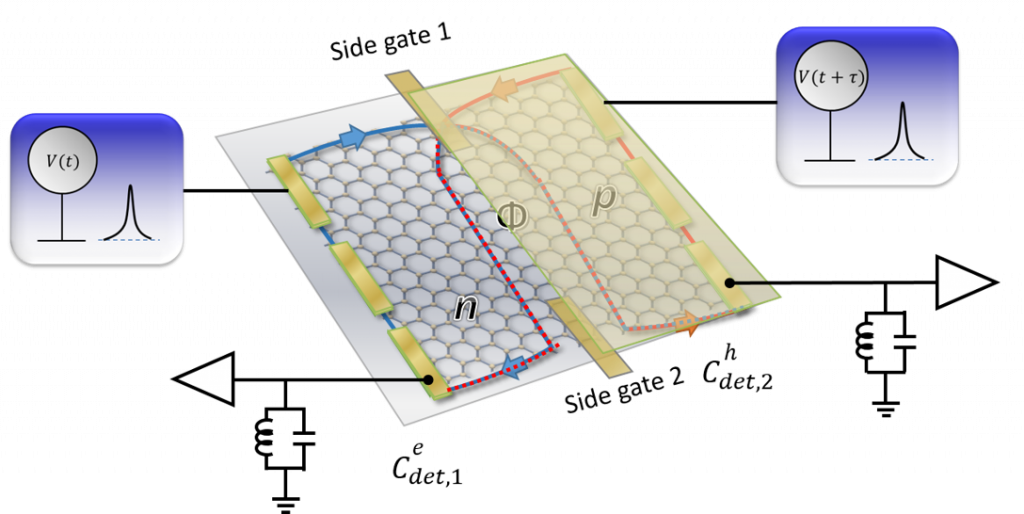
PAST PROJECTS
![]() H2020 FET OPEN: COSMICS (Concepts and tools in molecular spintronics). COSMICS consists in developing a molecular spintronic modeling platform that will help and stimulate basic and applied research, to bring out new molecular technologies in the field. More details (en) – (fr) COSMICS web page: http://cosmics-h2020.eu/
H2020 FET OPEN: COSMICS (Concepts and tools in molecular spintronics). COSMICS consists in developing a molecular spintronic modeling platform that will help and stimulate basic and applied research, to bring out new molecular technologies in the field. More details (en) – (fr) COSMICS web page: http://cosmics-h2020.eu/
Project leader: CEA, SPEC (C. Barreteau)
Partners: DTU (M. Brandbyge) / Synopsys (T. Markussen) / University-Paris, MPQ (A. Bellec) / CAU Kiel (R. Berndt) / UVEG (E. Coronado)
CEA project bottom-up DYNAMOL(DYNamique moléculaire magnétique dans les Alliages métalliques par un MOdèle de Liaisons fortes)
Magnetic tight-binding molecular dynamics in metallic alloys.
Partners: CEA, SPEC (C. Barreteau) / CEA DAM Le Ripault (Pascal Thibaudeau) / CEA DEN SRMP (Chu Chun Fu)
CEA project PTC Simulation PLANETHER (2018-2019)
Plateforme numérique pour l’étude du transport thermoélectrique dynamique dans des nanostructures
Numerical platform to study thermoelectric transport through nanostructures in the presence of time dependent perturbations
Partners: CEA/DRF/IRAMIS/SPEC (G. Fleury) et CEA/DRF/IRAMIS/PHELIQS (X. Waintal)
ANR Project: SPIROU (SPIn Resistance On Ultimate molecular devices)
The goal of SPIROU is to study the spin polarization on single molecular clusters to suggest reliable nanospintronics devices based on the fundamental understanding of interface spin properties down to the single molecule level. In this project it is of major importance to understand the typical mechanisms that can lead to the highest spin polarization in the molecular layer.
Project leader: U. Paris-Cité, MPQ (V. Repain)
Partners: CEA, SPEC, (C. Barreteau) / U. Paris Saclay, ICMMO (T. Mallah)
ANR Project: MAGMA (Magnetic Properties of Graphene Functionalized with 2D Molecular Assemblies)
MAGMA is a fundamental collaborative research project which aims to create novel functionalities in graphene by controlled manipulation of the electron spins.
Project leader: CEA, NIMBE (S. Campidelli)
Partners: CEA, SPEC, (Y. Dappe) / U. Paris Saclay, LPS (H. Bouchiat) / U. Paris Saclay, ISMO (A. Mayne) / Inst. Néel (J. Coraux)
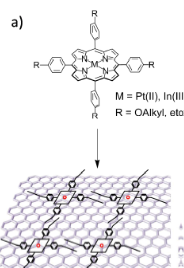
ANR Project: SMAL’LED (Single Molecule Architectures as Lowest-scale Light Emitting Devices)
Our project aims at combining molecular electronics and nanophotonics. We will explore the interactions between charge transport and light emission at the level of a single-molecule junction by designing and realizing model electroluminescent light sources made of individual molecules.
Project leader: U. de Strasbourg, IPCMS (G. Schull)
Partners: Sorbonne U., IPCM (F. Mathevet) / CEA, SPEC (F. Charra Y. Dappe)




